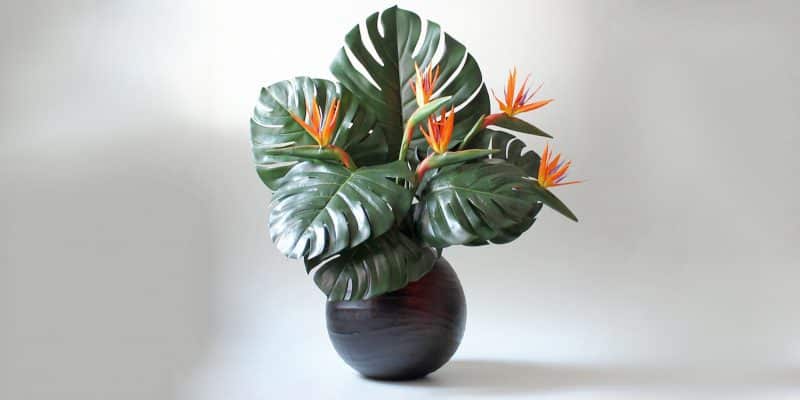With its brilliantly colored flowers and large, paddle-shaped leaves, Bird of Paradise isn’t your everyday botanical companion.
Not to be confused with the bird of paradise bird it resembles, the Bird of Paradise plant hides a relatively low-maintenance nature behind its striking appearance.
Wait, are we saying you can basically have a stunning floral bird as a pet and not even have to feed it? (Okay, okay, maybe fertilizer and water count).
We’ll cover everything you need to know about Bird of Paradise plant care, including a rundown of the different varieties, tips to help them thrive, and the best ways to encourage those beautiful blooms!
Table of Contents
Bird of Paradise Plant Care Guide
History, Habitat, and Characteristics

Bird of Paradise (Strelitzia reginae) features vibrant bird-like blossoms that give it the additional nicknames “crane flower” and “bird’s tongue flower.” Its boat-shaped, dark-green leaves provide a lush, tropical hideaway, and when in bloom, its stunning orange and blue flowers resemble a bird’s head and beak.
When you keep this plant outdoors, it can reach heights of up to 20 feet tall. But fear not! When grown indoors, the Bird of Paradise usually stays at a more manageable height of about 8 feet. You’ll have a dramatic statement piece without overwhelming your living space.
Bird of Paradise Varieties
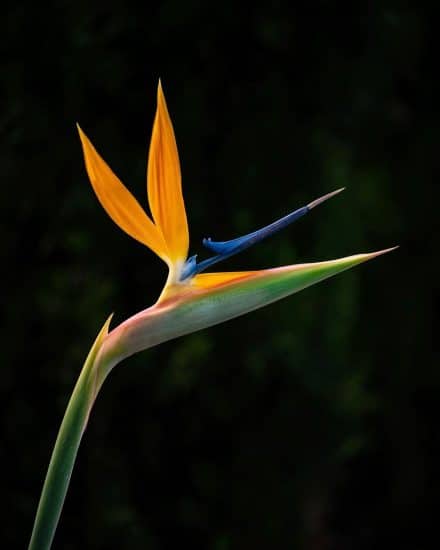
With origins in Southern Africa, the diverse Strelitzia genus includes a variety of species, such as nicolai, reginae, juncea, caudata, and alba. (The most common Strelitzia species are the first three — you’ll see why).
- Strelitzia nicolai, or giant Bird of Paradise, shows off banana-shaped leaves and elegant white flowers.
- Strelitzia reginae is the most well-known, the orange Bird of Paradise seen in ornamental beds in warm climates the world over.
- Strelitzia juncea, or narrow-leaved Bird of Paradise, is unlike other Strelitzia because it has no leaves at the end of its petioles — just the petioles themselves, narrow blue-green stalks. It produces orange and blue flowers, just like the reginae.
- Strelitzia caudata, or mountain strelitizia, is the rarest Strelitzia species and rarely found outside of Swaziland. This variety features a fan-shaped crown of white flowers with light blue petals and grey-green leaves.
- Strelitzia alba, white Bird of Paradise, has completely white blooms and can grow almost 30 feet tall . . . so you’re unlikely to find it as a houseplant!
Fun fact: The name “Strelitzia” was given in honor of Queen Charlotte of England, the Duchess of the House of Mecklenburg-Strelitz.
Getting Bird of Paradise to Bloom
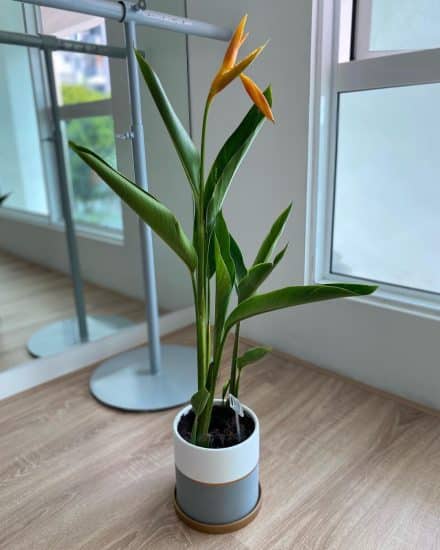
The number one reason why your gorgeous Bird of Paradise might not bloom is that it’s not getting enough light. Put it near a sunny window and make sure it gets a few hours of direct sunlight daily (we’ll get into this more in the next section).
Bird of Paradise also has a higher chance of blooming if it’s kept root-bound, so don’t be in a rush to repot!
Light
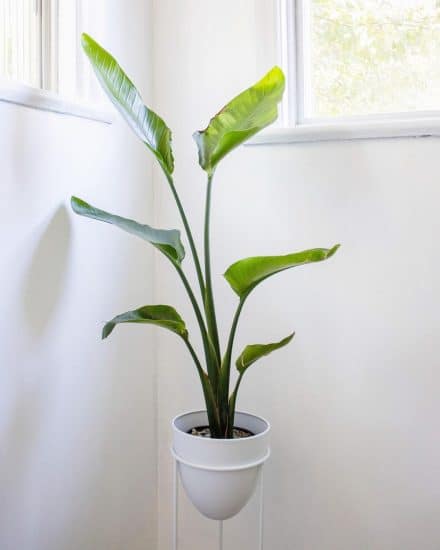
Bird of Paradise thrives in bright light and can handle a few hours of full sun each day. In fact, growing Strelitzia indoors usually requires 3-4 hours of direct sun per day. If you can achieve this, you might even be lucky enough to see those famous bird of paradise flowers.
It’s unlikely this tropical plant will get too much sun indoors unless your house is built of glass, but if it’s exposed to too much direct sun, you may notice the plant’s leaves looking scorched and burnt. In this case, adjust the lighting by moving your Bird of Paradise to a location with more indirect sunlight, or add a sheer curtain to the window.
Of course, if your plant is not receiving enough light, it may exhibit slow growth and leggy stems. To remedy this, consider relocating the plant to a brighter spot or introducing an artificial light (we recommend full-spectrum LED) to supplement its light requirements.
Water
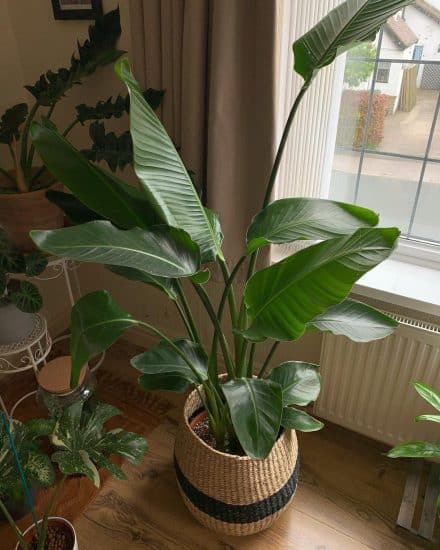
Your Bird of Paradise is a thirsty plant that requires consistent and thorough watering, especially when it’s getting the amount of light it needs. Allow the soil to dry out slightly between waterings, and when the top 2 inches of soil feel dry, it’s time to water your plant.
Saturate the soil well, ensuring your plant has proper drainage holes to prevent issues related to excess water. Strike the right balance by letting the soil dry out before watering again.
Signs of not receiving enough water include droopy leaves and excessive splitting. Monitor your plant for these symptoms and adjust your watering routine as needed. When you water, make sure the water flows from the drainage holes. This way, you’ll know you’re giving your plant enough water.
On the other hand, too much water can lead to droopy leaves, browning edges, and problems with the root ball. If this is the case, reduce your watering amount and frequency. It may also be time to evaluate pot and soil drainage.
Temperature and Humidity
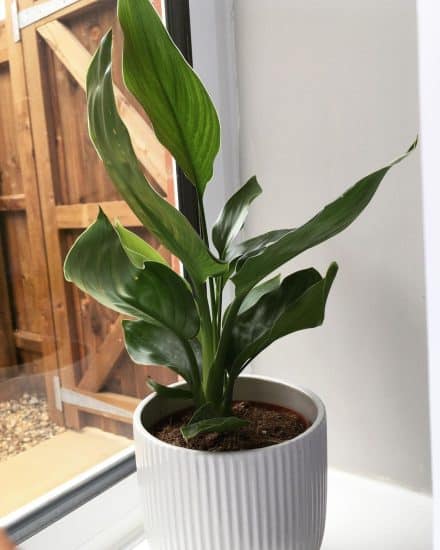
Bird of Paradise prefers a warm environment. To help your plant thrive, aim for stable temperatures between 65-75°F (18-24°C). These tropical plants can handle slightly lower temperatures at night but should be kept away from cold drafts and sudden temperature changes.
When it comes to humidity, Bird of Paradise plants thrive in higher levels, preferably no less than 50%. Maintaining the right humidity will prevent issues like browning edges and crispy leaves. If you notice either of these signs, there are a few measures you can take to increase the humidity around your plant.
To raise humidity:
- Run a humidifier near your plant for several hours each day.
- Position a pebble tray filled with water beneath the plant.
- Group your Bird of Paradise with other humidity-loving plants, such as banana plants, so they can share humidity through a process called transpiration.
- Relocate your plant to a naturally humid environment, such as a bathroom, if enough light is available.
Soil and Planting
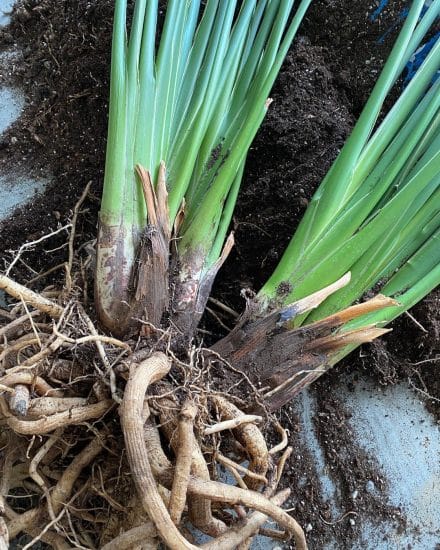
Interestingly, Bird of Paradise plants enjoy being slightly pot-bound, but when yours has outgrown its nursery grow pot, repot it in early spring. Opt for a pot that’s 5-10 centimeters larger in diameter and height than the previous one, with at least one drainage hole at its base.
For a well-draining potting mix, combine 70% premium potting soil, 15% charcoal, and 15% perlite. Alternatively, you can create a mix of 30% coco coir, 40% compost, and 30% pumice or perlite.
Fertilizing
Feed your Bird of Paradise during the growing season — spring and summer — by using a diluted fertilizer every few weeks or every other time you water. Be cautious not to over-fertilize. Start with a smaller amount of fertilizer and gradually build up. In the winter months, give your plant a necessary break from fertilizing.
If you notice signs of too much fertilizer, such as yellowing leaves, browning leaf tips, or a white crust on the soil surface, don’t panic! Flush out the excess water by watering your plant thoroughly. Let the pot fully drain and wait until the soil is dry before watering again.
Propagation
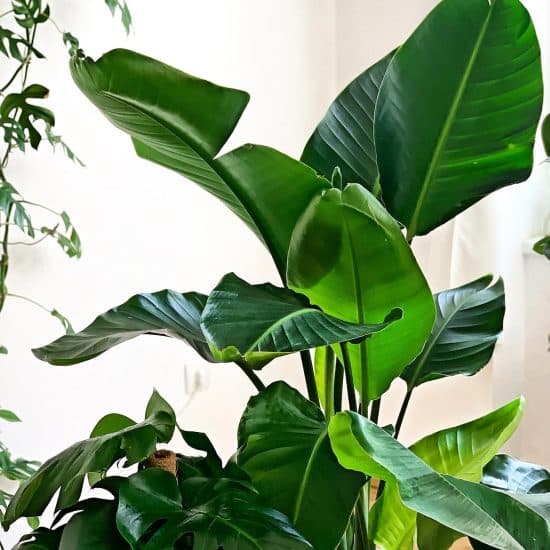
The primary propagation technique for Bird of Paradise plants is division. Follow this step-by-step guide, and you’ll be on your way to successful propagation in no time.
Propagating Bird of Paradise by division:
- Pick a Bird of Paradise plant with multiple stems or stalks. Choose a mature plant with at least two or more stalks. Each stalk will have its own root system, so the more mature the plant, the easier it will be to divide without causing harm.
- Gently expose the roots by removing the soil around them. Loosen the soil around the root ball of your Bird of Paradise plant carefully. This will allow you to separate the roots and stalks without damaging them during the division process. It might be easier to do this when the soil is moist.
- Carefully separate the stalks or use clean, sharp tools if needed. Use your fingers to gently pull apart the stalks, being careful not to break or harm the roots. If the roots are tangled, use sterilized knives or scissors to cut them apart with precision.
- Inspect the separated roots before potting. Have a look at your newly separated plants for any mushiness, damaged roots, or fungal infections, such as gray mold. Tackle any issues before potting to give your new Bird of Paradise plants the healthiest start possible.
Keep in mind that dividing a Bird of Paradise plant can cause some shock, which may lead to yellowing or drooping leaves. Stay patient and provide proper care to help the plant bounce back.
Common Issues
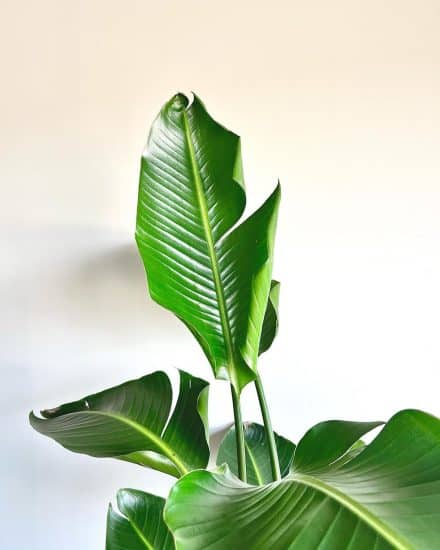
Caring for a Bird of Paradise plant isn’t overly complicated, but you might have to deal with the occasional brown leaves or pest.
Browning Leaf Edges
Browning leaf edges are a typical concern with Bird of Paradise plants, often resulting from insufficient humidity or inconsistent watering. Boost the humidity around your tropical plant by using a humidifier or setting the pot on a tray filled with water and pebbles. The evaporating water will increase moisture levels.
Make sure you’re watering your Bird of Paradise plant regularly, using well-draining soil and carefully balancing the soil’s moisture — neither too wet nor too dry.
Stuck Leaves
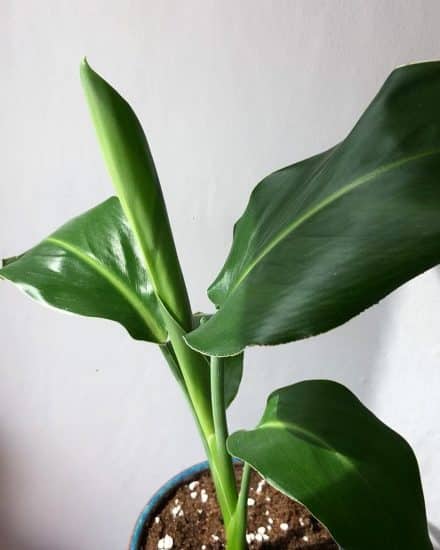
At times, Bird of Paradise plants might experience stuck leaves — you know the type, when you can practically feel them trying to wriggle free! If new growth leaves struggle to fully unfurl, gently mist the leaves with lukewarm water, which can help loosen the stuck leaf. Alternatively, you could use a damp paper towel and gently wipe the leaf, assisting it in separating the foliage.
Pests and Diseases
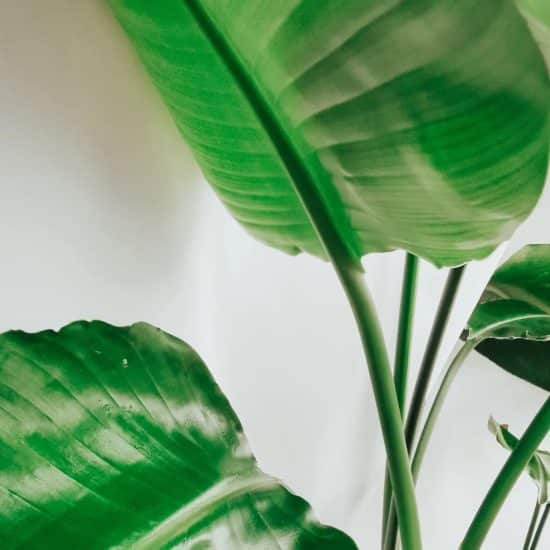
Bird of Paradise usually sails through life without many problems involving pests and diseases. But just in case . . .
Pests
Look out for uninvited guests that might target your Bird of Paradise:
- Scale
- Aphids
- Mealybugs
- Whiteflies
- Spider mites
For any of these pests, clean the leaves with a cotton ball or cloth dipped in rubbing alcohol or hand sanitizer and gently remove the insects from the leaves and stems. Then, spray your plant with a diluted dishwashing liquid and neem oil solution. For whiteflies, you may also need to use yellow sticky traps.
It’s a good idea to move your plant out of direct light when you’re treating it with an insecticide, or even diluted soap. The combination of the products and hot sun can damage the leaves.
It’s crucial to dust and clean your Bird of Paradise leaves regularly to keep pests at bay. Keep a lookout for any signs of infestation and get rid of these invaders the moment you spot them so your plant stays happy and healthy.
Root Rot
Although relatively resistant to pests and diseases, Bird of Paradise can still experience root rot if overwatered. Root rot gives itself away through wilting leaves, a musty smell, and soft, dark, or slimy roots.
Here’s how you can fix it: Remove your plant from its pot, trim off any affected roots with sterilized scissors, and repot it in fresh, well-draining soil. And remember, go easy on the watering next time.
Bacterial Wilt
Bacterial wilt is another challenge your Bird of Paradise might face. Keep an eye out for yellowing and wilting leaves, as well as a slimy ooze coming from the stems. To treat bacterial wilt, trim away affected areas with sterilized scissors and apply a copper-based fungicide to the rest of your plant.
In the end, prevention is the best medicine when it comes to your Bird of Paradise ‘s well-being. Make sure to provide the right growing conditions, such as bright light and well-draining soil, and inspect your plant regularly for any signs of pests or diseases.
Conclusion
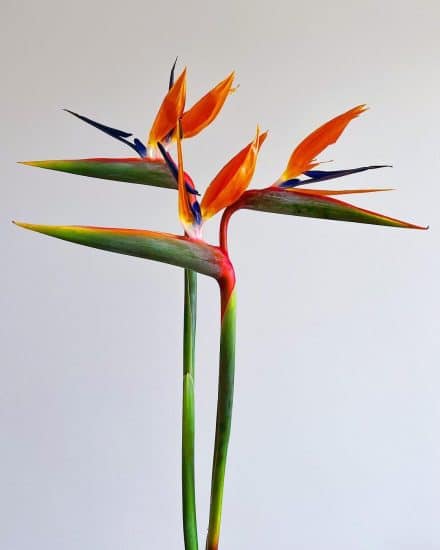
That’s a wrap for our Bird of Paradise care guide!
Despite its diva-esque appearance, caring for this striking indoor plant is relatively easy. And those vibrant blooms? Remember, lots of sunshine, a few daily hours of direct, and not too much repotting.
Bird of Paradise care summary:
- Provide bright light with a few hours of direct sunlight to mimic its natural habitat.
- Water consistently, allowing the top of the soil to dry out between watering.
- Maintain humidity levels around 50% and ensure stable temperatures of 65-75°F (18-24°C).
- Use a well-draining potting mix and repot mature plants every 1-2 years in early spring.
- Fertilize during the growing season, but don’t overdo it.
If you found this guide helpful, share it with fellow plant lovers! And if you have any questions or concerns we didn’t cover, as always, feel free to reach out to us any time.
(Also, if you snag one of these beauties, please send us pics)!
Enjoy life in paradise!
FAQ
Is Bird of Paradise easy to care for?
Yup, despite its intimidating appearance, Bird of Paradise is relatively easy to take care of! For the healthiest plant and the best chance of those salivation-worthy Bird of Paradise flowers, make sure to provide bright, indirect light with a few hours of direct sunlight each day. Maintain a consistent watering schedule too, allowing the soil to partially dry between waterings.
Should I cut the brown leaves off my Bird of Paradise?
Yes, it’s a good idea to remove any brown or yellowed leaves from your Bird of Paradise. This helps maintain the plant’s overall appearance and promotes healthy growth patterns. To remove the damaged leaves, use a clean, sharp pair of pruning shears or scissors and cut the leaf at the base, close to the main stem.
Be cautious not to damage any healthy leaves or stems during the process. Regularly pruning your plant will not only improve its aesthetic appeal but also enhance its health by redirecting valuable energy into producing new growth.
Is Bird of Paradise an indoor or outdoor plant?
Bird of Paradise can thrive both indoors and outdoors, depending on the climate and conditions. It’s safe to grow Bird of Paradise outdoors year-round in regions with warmer climates (USDA zones 10-12) where temperatures stay consistently above 55°F (13°C).
In areas with cooler climates, Birds of Paradise can be grown in pots and brought indoors during colder months to protect them from frost and low temperatures. When grown indoors, be sure to provide sufficient light and humidity to mimic the plant’s natural habitat.
How long does a Bird of Paradise plant last?
A well-cared-for Bird of Paradise plant can have a very long life-span, sometimes living for decades. To ensure that your plant lasts, follow proper care guidelines, such as providing adequate lighting, maintaining a consistent watering schedule, and repotting as needed.
What’s the difference between Strelitzia reginae and Strelitzia nicolai Bird of Paradise plants?
Both Strelitzia reginae and Strelitzia nicolai are Bird of Paradise plants, but with a few differences. Strelitzia reginae showcases striking orange and blue flowers on a relatively smaller plant (reaching up to 6 feet tall). Strelitzia nicolai, or the giant white Bird of Paradise, is known for its large white flowers and can grow significantly taller (up to 30 feet).
Is Bird of Paradise toxic?
According to the ASPCA, Bird of Paradise is considered toxic to animals, so best to keep it away from curious critters and small humans too.
Sources
- https://plants.ces.ncsu.edu/plants/strelitzia-reginae/
- https://hort.extension.wisc.edu/articles/bird-of-paradise-strelitzia-reginae/
- http://www.missouribotanicalgarden.org/PlantFinder/PlantFinderDetails.aspx?taxonid=282766
- https://www.aspca.org/pet-care/animal-poison-control/toxic-and-non-toxic-plants/bird-paradise-flower

